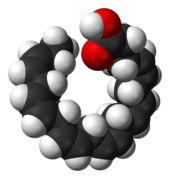Docosahexaenoic acid
 |
|||
|
|
|||
| Names | |||
|---|---|---|---|
|
IUPAC name
(4Z,7Z,10Z,13Z,16Z,19Z)-docosa-4,7,10,13,16,19-hexaenoic acid; Doconexent
|
|||
| Other names
cervonic acid, DHA
|
|||
| Identifiers | |||
|
6217-54-5 |
|||
| 3D model (Jmol) | Interactive image | ||
| ChEBI |
CHEBI:28125 |
||
| ChEMBL |
ChEMBL367149 |
||
| ChemSpider |
393183 |
||
| ECHA InfoCard | 100.118.398 | ||
| 1051 | |||
| PubChem | 445580 | ||
| UNII |
ZAD9OKH9JC |
||
|
|||
|
|||
| Properties | |||
| C22H32O2 | |||
| Molar mass | 328.488 g/mol | ||
| Density | 0.943 g/cm3 | ||
| Melting point | −44 °C (−47 °F; 229 K) | ||
| Boiling point | 446.7 °C (836.1 °F; 719.8 K) | ||
|
Except where otherwise noted, data are given for materials in their standard state (at 25 °C [77 °F], 100 kPa).
|
|||
|
|
|||
| Infobox references | |||
Docosahexaenoic acid (DHA) is an omega-3 fatty acid that is a primary structural component of the human brain, cerebral cortex, skin, and retina. It can be synthesized from alpha-linolenic acid or obtained directly from maternal milk (breast milk), fish oil, or algae oil. DHA's structure is a carboxylic acid (-oic acid) with a 22-carbon chain (docosa- is Greek for 22) and six (hexa-) cis double bonds (-en-); with the first double bond located at the third carbon from the omega end. Its trivial name is cervonic acid, its systematic name is all-cis-docosa-4,7,10,13,16,19-hexa-enoic acid, and its shorthand name is 22:6(n-3) in the nomenclature of fatty acids.
Most of the DHA in fish and multi-cellular organisms with access to cold-water oceanic foods originates from photosynthetic and heterotrophic microalgae, and becomes increasingly concentrated in organisms the further they are up the food chain. DHA is also commercially manufactured from microalgae: Crypthecodinium cohnii and another of the genus Schizochytrium. DHA manufactured using microalgae is vegetarian.
Some animals with access to seafood make little DHA through metabolism, but obtain it in the diet. However, in strict herbivores, and carnivores that do not eat seafood, DHA is manufactured internally from α-linolenic acid, a shorter omega-3 fatty acid manufactured by plants (and also occurring in animal products as obtained from plants). Limited amounts of eicosapentaenoic and docosapentaenoic acids are possible products of α-linolenic acid metabolism in young women and men, and though DHA is difficult to detect above dietary background in males compared with females, this illustrates the importance of DHA production for the developing fetus and healthy breast milk. Rates of conversion are 15% higher for women, with those taking oral contraceptives demonstrating 10% higher DHA levels.
...
Wikipedia


